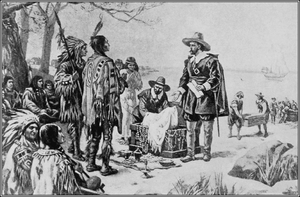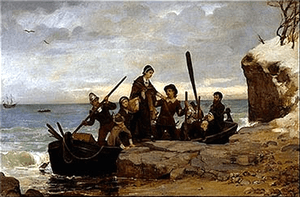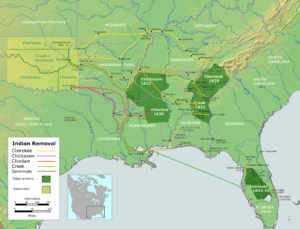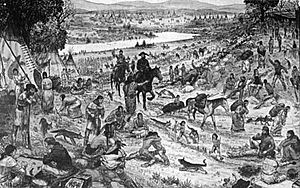Indian commerce with early English colonists and the early United States facts for kids
Native American commercial development describes how Native American tribes changed their economies. They went from being hunter-gatherer societies to focusing on the fur trade. This happened from the early 1500s to the 1800s. During this time, relationships between tribes and with Europeans changed as English settlements grew into the United States.
Each tribe's trade depended on its location and resources. Before Europeans arrived, Native American trade was mostly with nearby tribes. It helped define tribal and social connections. Tribes traded goods based on what they specialized in. However, no tribe relied completely on outside trade to survive. When Europeans arrived, tribes began to specialize in the fur trade. They exchanged furs for European goods.
Trade between Native Americans and English settlers started in the 1500s and lasted until the 1800s. Early on, the English and local tribes relied on each other for animal furs and pelts. New English settlements like Jamestown and Plymouth needed local tribes for many things. As these settlements grew into colonies, disagreements increased. English colonists took more land, leading to conflicts like King Philip's War.
As English colonies grew, they needed less from the tribes. Native American tribes in the Northeastern woodlands started to rely more on goods from the colonies. By the time the United States was formed, tribal trade was becoming less important. The growth of the United States led to Native Americans losing their rights and lands. Goods like furs, which Native Americans provided, became less important to the American economy. Laws were made that forced Native American tribes onto reservations in the West. By the 1800s, Native American trading power had almost disappeared. Today, Native Americans are involved in gaming casinos and sell cultural goods.
Contents
Early Native American Trade
From the 1500s, Native American societies were mainly hunter-gatherers or farmers. This period is called the Pre-Columbian Era. What each tribe specialized in depended on their land. For example, Iroquois tribes in the Northeast hunted moose and shellfish. Before Europeans arrived, many tribes focused on furs. The first trade of European goods for Indian furs began in 1641. French Jesuit priests in the Great Lakes region started this. This led to the growth of the fur trade, especially for beaver pelts. This trade opened the way for French and later English colonization.
European arrival changed not only the economy but also the social structure of tribes. New groups and alliances formed.
Native American Trade Before Colonization
Native American trade depended a lot on the land around each tribe. These areas had loose cultural boundaries that shaped how tribes traded. Here are some of these regions:
- Northeastern Woodlands
- Southeastern Woodlands
- Great Plains
- Great Basin
- Northwest Plateau
- Northwest Coast
- California
- Southwest
The exact details of trade before European contact are not fully known. However, we know that luxury goods like copper, shells, and stone traveled long distances. Trade of everyday items, like food, was usually limited to nearby tribes.
Native American trade was not about making a profit. It was about getting useful goods that a community needed. It also helped strengthen social and land boundaries. For example, the Huron tribe traded extra farm produce to the nearby Algonkians.
The first trade with Europeans involved furs and farm goods. In return, Native Americans received metals and cloth. This trade was mainly in the Northeastern Woodlands and Great Lakes area. This led tribes to specialize more in the fur trade. Trading furs for European goods became very helpful for tribes. However, this also led to fewer beavers and overuse of resources. European companies started using Native American furs and labor extensively between the 1600s and 1700s.
The fur trade also created strong social and political boundaries between tribes. It led to the formation of alliances and confederacies. Important groups that formed in the 1630s include the Iroquois nation, the Pontiacs of 1760, and the alliance of Algonqian tribes that traded with the French. These groups developed because of the fur trade.
Trade with English Settlers
When English settlers arrived in the New World, trade became important for peace and survival. To have a good relationship with the Native Americans in the United States, the English traded goods. These included food, spices, weapons, and tools. In return, they got access to fertile lands, waterways, and rough maps. Early trade relationships were generally healthy. Native Americans saw trade as a way to benefit both sides. This helped British colonization of the Americas succeed. However, challenges arose when settlers sometimes took advantage of Native American goods. This slowly damaged trust between tribes and settlers.
Plymouth and Northern Settlers
Plymouth is a town in Massachusetts. It is famous in American history and was founded in 1620 by the Pilgrims from the ship Mayflower. Before the Mayflower arrived, earlier European explorers brought diseases. These diseases killed 90% to 95% of the local Native Americans. This meant the Pilgrims could take over their cornfields and cleared areas. The remaining Native Americans were too weak to stop the colonists. With fewer people, they relied heavily on trade to survive. They traded animals for farmland and farming skills. The relationship was good until the Dominion of New England was formed.
Jamestown and Southern Settlers
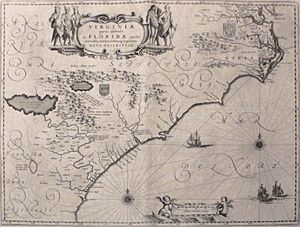
Jamestown and other Southern settlers relied heavily on Native Americans for food. Native Americans gladly traded food for precious metals. The Jamestown site was swampy and had bad drinking water. So, Native Americans traded farm products, building materials, and some animals. In return, they received metals, glass, tools, and other items they had not seen before. As settlers explored beyond Jamestown, Native Americans often welcomed them with dancing, feasts, and tobacco ceremonies.
As relationships grew, so did the need for trade. Native Americans realized these explorers planned to stay and expand. After years of difficult coexistence, Chief Opechancanough and his Powhatan Confederacy tried to remove the English. On March 22, 1622, they attacked settlements along the James River. This event, known as the Indian massacre of 1622, killed over 300 settlers.
Trade with English Colonies
As English colonies became permanent, trade was even more important for keeping peace with Native Americans. For many colonies in the Eastern States, Native Americans resisted the growing English presence. Large, fast-growing colonies threatened Native American lands. Also, new diseases from Europeans spread quickly among Native American communities. Trade became difficult and limited during these times of sickness. In some Native American stories, white people became hated. More successful trade routes happened with explorers and mapmakers. They were seen as less of a threat and often stayed in Native American territory for days to survive.
Northern Colonies (New England)

The Northern Colonies, also called the New England Colonies, included Connecticut, Rhode Island, Massachusetts, and New Hampshire. They were part of the Thirteen Colonies. They mostly traded furs, especially with the Pequot Indians. However, most relationships broke down due to disease and land arguments. This eventually led to King Philip's War in 1675. This was the deadliest war in New England's history. It helped create a stronger European American identity. This war almost stopped all trade between English colonists and Native Americans in the area.
Southern Colonies
Trade in the southern colonies included the Carolinas, Georgia, and Florida. The trade of Native American people as slaves was common in the southern colonies and Florida in the 1600s and early 1700s. This was especially true in the American Southeast. Many people think only Africans were enslaved in the Americas. However, in some southeastern colonies, Native American enslaved people sometimes outnumbered those of African descent. Native Americans were sometimes forced to work on farms or as servants. They also worked as interpreters for European traders.
In many cases, colonists traded with Native Americans. They gave them goods and weapons, like muskets. In return, they received beaver pelts and the capture of other Native Americans from rival tribes to be sold into slavery. This trade was not sustainable. The Native American population was being wiped out. Those who were not killed or captured became the captors. As fewer Native Americans were available for capture, the captors fell into debt with the colonists. This debt and frustration led to the Yamasee War of 1715. This war eventually ended the trade system in the Carolinas.
The English Traders
English traders followed established French trading routes through the Midwest Colonies. They traded for fur and tools like buckets, axes, and hammers. Native Americans usually welcomed them after these routes were set up. They often provided shelter, food, or protection from other tribes. As trading posts were built, trade grew between traders and Native Americans. As traders moved into new, unexplored areas, they sometimes met resistance from new tribes.
Trade with the Early United States
After the United States was formed, the government began to control trade with Native Americans. The Indian Intercourse Act was passed on July 22, 1790. For the first time, the United States regulated trade with Native Americans in the United States. The government created the Bureau of Indian Affairs. This agency was in charge of giving out licenses to trade in Indian Territory.
As more people moved west in the United States, more and more Native Americans in the United States were pushed off their lands. Wars continued, such as Tecumseh's War. This was a conflict between the United States Army and a Native American confederacy. It eventually became part of the War of 1812. These wars damaged relations between Native Americans and the United States.
During this time, many fur companies started across America. The American Fur Company, founded in 1808, was one of the largest. As the 1800s continued, fur became less popular as fashion trends changed. The Native American economy relied heavily on goods from the fur trade. When it slowed down, they had to find other ways to get the goods they needed. Native Americans began to sell their land to settlers, often in forced situations. These difficult deals led to more armed conflicts.
Trade with Southern Indians
Most Native Americans in the United States tribes in the South were forced to move during the Indian Removal in the 1830s. These tribes were moved to Indian Territory, west of the Mississippi River. The Muscogee, also known as the Creek, were a Native American people in the southeastern woodlands. This area included parts of Oklahoma, Alabama, Georgia, and Florida. The Muscogee were very involved in the deer skin trade. Their main hunting grounds were in Savannah and Florida.
Some Muscogee moved south into Florida and became known as the Seminoles. In the early 1800s, conflicts between the Seminoles and white settlers became more frequent. By the end of the 1800s, over 3,000 Seminoles had been moved. Only about 200 to 300 remained in Florida. As a result, trade in the southern states stopped at the end of this era.
Trade with the West
In the early 1800s, trade with Native Americans in the United States was common. Trade with Native Americans in the Midwest mostly involved beaver fur. In return, Native Americans received horses, guns, and other goods they could not make themselves. During the Indian Removal at this time, the government pushed many tribes into western states like Kansas, Kentucky, and Missouri.
The Shawnee was one tribe pushed from Pennsylvania into Ohio, Alabama, and Illinois. The Shawnee traded fur for rum or brandy. The Comanche tribe also lived in the southern plains.
The Comanche tribe were mostly farmers before conflicts over the fur trade began due to Europeans. After these "fur wars," the Comanches were pushed from eastern lands into bison hunting territory. By the 1800s, the Comanche tribe were mostly nomadic. They relied heavily on hunting bison to survive. Bison fur was also traded with other tribes and with villagers in Missouri. The Cheyenne, Kiowa, and Arapahoes tribes also traded bison. These four tribes constantly looked for good buffalo hunting grounds and horse herds to trade with Missouri villagers and southern horse suppliers.
A common way of trading in the West was through the Rocky Mountain Rendezvous. This was an annual gathering held in different locations. Large fur companies like the American Fur Company brought mule trains loaded with goods. These included whiskey, ammunition, and other supplies needed for life in the West. Native Americans in the United States were not the only ones who attended. Mountain men and trappers also came to trade their furs and hides. The Rendezvous was a chance for all traders to get new supplies, share ideas, and socialize. Native Americans usually brought their whole families and were seen as unique by others there.
Trade with the United States (1820-1870)
Conflicts with Native Americans increased during this time. The idea of "Manifest Destiny" (the belief that the U.S. was meant to expand across the continent) influenced how the U.S. government dealt with tribal nations. During this era, the Indian Removal Act of 1830 was passed. This led to the forced removal of many eastern Native American tribes. The last treaty with Native Americans, known as The End of Treating Making 1871, ended government recognition of Native American tribes. It also led to the creation of Indian reservations, which still exist today. This loss of rights for Native Americans marked the end of official trading with the United States.
Eastern United States
The Indian Removal Act of 1830, signed by President Andrew Jackson, allowed the President to exchange unsettled lands west of the Mississippi River for Native American lands within existing states. Because of this act and the Second Seminole War, official trade of goods on the East Coast ended. By 1839, the Cherokee nation was forced to leave their land and move to what is now Oklahoma. The Cherokee people called this journey the Trail of Tears because it was so devastating. About 4,000 out of 15,000 Cherokees died.
Mid-West
In 1828, Fort Union in Upper Missouri was a main center for most fur companies. Individual traders like Wyeth, Bonneville, Pilcher, and Fontenelle made it competitive for established fur companies. By 1834, the fur trade was at its peak. Half a dozen organized companies in the United States competed with the American Fur Company. By 1830, the American Fur Company had taken over most of the fur trade industry in the United States. Companies competing with the American Fur Company found it helpful to use the Native Americans' wandering habits. They had general meeting points, but most hunters were sent in different directions. Without storehouses, hunters would bury their furs until the annual caravan was sent to St. Louis.
Utah
The Ute nation and Paiutes had ongoing conflicts with Mormon settlers. Although some agreements were made, the Mormons' use of resources and wildlife eventually ended peaceful relations. The Mormons tried to stop the New Mexican trade. This disrupted the Ute economy and society. On July 17, 1853, a disagreement between James Ivie and some Ute members led to one Ute member being killed. This dispute and other issues led to the Walker War.
California
The California gold rush led to a major decline in the Native American population on the west coast. Miners, loggers, and settlers formed groups to hunt Native Americans living outside mission communities. In 1845, the Native American population was about 150,000. By 1870, it had dropped significantly to 30,000. This huge decrease was due to deadly diseases, less wildlife and resources, and constant attacks from new arrivals, including English and European migrants.
United States Laws on Trade with Native Americans
Articles of Confederation
Under the Articles of Confederation, the central government was not very strong or effective. Congress could not pass or enforce laws. For example, Congress could not tax; it could only ask for money. This meant there were not enough funds for soldiers, bondholders, or to control currency. This made it hard for Native Americans to trade or sell goods. Also, without a single currency, prices for their goods and services could change a lot. Different types of money also made trading harder. However, the Articles of Confederation did allow the federal government to regulate trade with Native American tribes.
The Articles of Confederation did not address trade between states. This led to unnecessary taxes and fees between states. This affected Native American trade because they still had to pay taxes, but on a state-by-state basis. This could lead to unfair taxes. Depending on the area, some tribes had conflicts and wars with colonists, which made relations tense.
United States Constitution
Under the Articles of Confederation, Congress had no power to regulate trade. So, each state controlled its own trade with other states. This was difficult for Native American trade because there was no unity between the states. Each state had its own rules, which made trade even more complicated for Native Americans. However, the Confederation Congress worked hard to keep peace between white settlers and Native Americans. To maintain peace, Congress could raise armies and appoint people to settle disagreements.
Under the new Constitution, the framers added the Commerce Clause:
(Article 1, Section 8, Clause 3): “To regulate Commerce with foreign Nations, and among the several States, and with the Indian Tribes;”
The goal was to regulate trade among four groups: Native American tribes, foreign countries, states, and the U.S. federal government. The Constitution gave more power to the federal government over Native American tribes through the Trade and Intercourse Acts. It also used Article II, Section 2, Clause 2 (Treaty Clause), and:
Article IV, Section 3, Clause 2 (Property Clause): The Congress shall have Power to dispose of and make all needful Rules and Regulations respecting the Territory or other Property belonging to the United States; and nothing in this Constitution shall be so construed as to Prejudice any Claims of the United States, or of any particular State.
Within ten years of the Constitution being approved, Congress passed The Northwest Ordinance (1785). This was to raise money by selling Western land. Under this law, the governor could divide the land into counties and townships:
Section 8. For the prevention of crimes and injuries, the laws to be adopted or made shall have force in all parts of the district, and for the execution of process, criminal and civil, the governor shall make proper divisions thereof; and he shall proceed from time to time as circumstances may require, to lay out the parts of the district in which the Indian titles shall have been extinguished, into counties and townships, subject, however, to such alterations as may thereafter be made by the legislature.
Section 14, Article III shows the ideal relationship between Native Americans and the government: Religion, morality, and knowledge, being necessary to good government and the happiness of mankind, schools and the means of education shall forever be encouraged. The utmost good faith shall always be observed towards the Indians; their lands and property shall never be taken from them without their consent; and, in their property, rights, and liberty, they shall never be invaded or disturbed, unless in just and lawful wars authorized by Congress; but laws founded in justice and humanity, shall from time to time be made for preventing wrongs being done to them, and for preserving peace and friendship with them.
Federal Involvement
Johnson v. M'Intosh showed that the new central government supported property rights. It stated that private citizens could not buy Native American land. Only the federal government had the right to negotiate with tribal nations.
Cherokee Nation v. Georgia was a case that took away rights from the Cherokee Nation. The court argued that the tribe had no original jurisdiction because they were a sovereign tribe. Supporters upheld this decision under Article III of the Constitution.
Worcester v. Georgia discussed the basics of state government. It set boundaries that aimed to ensure peace and privacy with the Cherokee Nation. In a 5-1 decision, the court sided with Worcester. It argued that the state of Georgia did not have the power to control interactions between its citizens and members of the Cherokee Nation.
In 1830, President Andrew Jackson signed The Indian Removal Act. This law forced Native Americans east of the Mississippi River to move west. This was because American settlers wanted to live on their lands.


